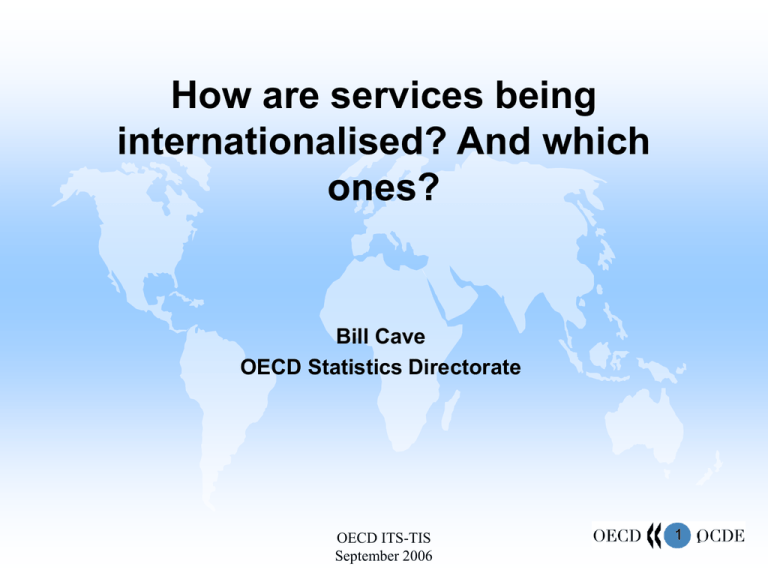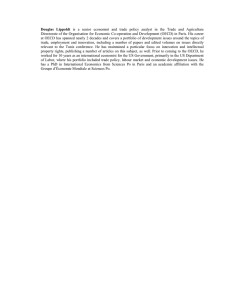How are services being internationalised? And which ones? Bill Cave
advertisement

How are services being internationalised? And which ones? Bill Cave OECD Statistics Directorate OECD ITS-TIS September 2006 1 1 Overview Internationalisation of services? A number of strands of OECD statistical and analytical work are relevant FDI, Trade in services, Globalisation indicators Also Information Society and Migration What evidence is there? Conclusions and future needs Conceptual work OECD Benchmark Definition of FDI (with IMF and others) Manual on Statistics of International Trade in Services (an Interagency joint work) OECD Handbook on Economic Globalisation Indicators Other OECD work: ICT, e-commerce definitions, and Guide to measuring the Information Society. General perceptions about trade in services Barriers to trade in services – – – – ‘Not tradeable’ by definition Physical proximity or link Language, culture Many regulatory barriers Services that facilitate goods trade – Freight transport, logistics – Insurance, export credit services – Wholesale distribution Business services follow multinationals Internet, telecommunications, IT services allow more remote delivery Increasing movement of people Worldwide information – International TV, Newspapers, Magazines, Search engines OECD ITS-TIS September 2006 4 4 Evidence? 1 FDI data Increase in services proportion of FDI flows Led by financial services, RE and business services, transport and communication services. Evidence partly distorted by SPEs Definition of services in terms of ISIC sections E to P Evidence? 2 International trade in services Resident-nonresident trade only 20% of total trade and stable Research confirms distance more important for services Transport and travel still 50% of services trade 2004 Fastest growing services (nominal values): – – – – Computer and information services Insurance and financial services Royalties and license fees Other business services Services defined by BPM5 classification Evidence? 3 FATS New data source: statistics are patchy, difficult to aggregate More service sales through foreign affiliates than cross-border trade Foreign affiliates more likely to sell locally services than goods For sales: wholesale biggest, followed by financial, RE & business services, transport & communication Services defined by ISIC sections G to P OECD ITS-TIS September 2006 7 7 Other evidence? ICT sector is highly and increasingly globalised Increasing range of services can be delivered remotely – offshoring Statistical puzzle related to India/China exports of services and OECD imports Migration – increasing inflows of foreign born into OECD countries Plans to collect more data on migrants e.g. occupation, age, gender, education, year of arrival, sector of activity Private sector sources on multinationals – useful background difficult to square with official data Conclusions Official data provide useful but limited insights into internationalisation Most internationalised appear to be wholesale financial/insurance, IT services, freight transport and couriers. Services that can be delivered digitally are increasingly internationalised Distance, culture, language and regulatory barriers are important factors Suggestions for future work Difficult to analyse FDI,TIS, FATS and Enterprise statistics in same framework More cooperative work on definitions, linking data sets Multinationals have to be looked at internationally as well as nationally Measure trade based on economic control v trade based on residency (connected to modes of supply) Economic impact of migration => more links to BOP (remittances) and employment statistics OECD ITS-TIS September 2006 10 10 Thank you for your attention

